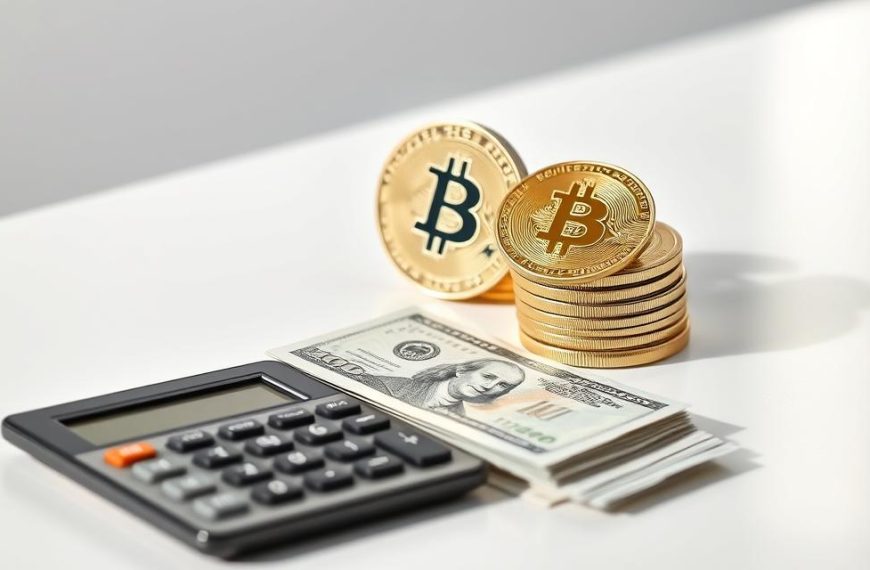Converting crypto assets to bank funds can be tricky. The digital finance world keeps changing. There are many ways to turn your crypto into cash1.
Cryptocurrency has become a popular investment choice. Investors now look for easy ways to transfer crypto to their banks. The new spot Bitcoin ETFs in 2024 have made Bitcoin trading simpler1.
Digital platforms offer more withdrawal options. Binance P2P lets sellers set their own rates. It has over 14 million users worldwide1.
Cash App allows Bitcoin purchases for just $1. This makes crypto transactions more accessible to everyone1.
Withdrawing cryptocurrency can be tricky. Some exchanges require converting to stablecoins first. This adds extra steps to the process1.
Crypto prices can change quickly. This affects the final value of your digital assets. Tax implications are also important to consider1.
Selling crypto may trigger capital gains tax. The tax depends on how long you’ve held the assets. Plan carefully to get the best results in the crypto market1.
Understanding Cryptocurrency Withdrawals: A Comprehensive Guide
Cryptocurrency withdrawals are crucial for digital asset investors. They convert digital holdings into spendable currency. This process involves complex mechanisms of digital exchanges.
What Are Cryptocurrency Withdrawals?
Cryptocurrency withdrawals move digital assets from online platforms to personal bank accounts. This turns digital currencies like Bitcoin into traditional money. Digital exchanges play a key role in these transactions.
The Role of Digital Exchanges
Digital exchanges are vital intermediaries in cryptocurrency transactions. Platforms like Binance support millions of users worldwide. They offer comprehensive withdrawal services for various cryptocurrencies and fiat currencies.
Understanding Transaction Fees and Limits
Transaction fees and withdrawal limits are important for crypto investors. Withdrawal fees differ for each cryptocurrency.
- Bitcoin (BTC): 0.0004 BTC per withdrawal2
- Ethereum (ETH): 0.003 ETH per withdrawal2
- Ripple (XRP): 0.25 XRP per withdrawal2
Some exchanges allow transactions up to £100,0003. Processing times vary from hours to days. This depends on the chosen platform and transfer method3.
Note: Cryptocurrencies remain unregulated in the UK. Consider potential tax implications, including Capital Gains Tax, before making withdrawals.
Can You Withdraw Cryptocurrency to Bank Account: Step-by-Step Process
Converting digital assets to fiat currency requires careful attention. The process involves crucial steps for a smooth bank transfer4. Understanding this approach helps investors move funds from digital wallets to bank accounts.
- Verify your identity on the chosen cryptocurrency platform
- Link your bank account or international bank number (IBAN)
- Select the cryptocurrency you wish to convert
- Choose your preferred fiat currency
- Specify the withdrawal amount
Withdrawal times can vary greatly. Most platforms process transactions within 1-5 days, though some offer near-instant transfers4.
Users should expect potential verification steps, especially when using bank transfer methods like SEPA4.
| Withdrawal Method | Typical Processing Time | Potential Fees |
|---|---|---|
| Bank Transfer | 1-5 days | Network + Withdrawal Fee |
| Instant Transfer | Minutes | Higher Transaction Cost |
It’s vital to understand platform-specific limits. Some exchanges set daily withdrawal caps at BTC 10 or equivalent4.
Users must review their chosen platform’s restrictions to avoid complications. This ensures a smooth crypto withdrawal process.
Always double-check transaction details when converting cryptocurrency to fiat. Your final amount will be the requested sum minus applicable fees4.
Strategic planning ensures a seamless transfer from digital wallet to bank account. Be mindful of all steps involved.
Popular Platforms for Crypto-to-Fiat Conversions
Transforming digital assets into traditional currency requires knowledge of various platforms. UK investors have multiple options for converting their crypto holdings efficiently and securely.
Centralised Cryptocurrency Exchanges
Coinbase and Binance are leading crypto exchanges for converting cryptocurrencies to fiat currency. Coinbase is favoured by beginners for its user-friendly interface5.
Binance offers lower transaction fees and supports over 600 cryptocurrencies6. Both platforms provide robust features for traders of all levels5.
- Coinbase supports over 240 cryptocurrencies with strong security features6
- Binance offers industry-leading low fees with additional token discounts6
- Gemini provides trading options across 70 countries globally6
Peer-to-Peer Trading Platforms
LocalBitcoins and Paxful allow direct exchanges between users. These platforms offer more flexible payment options compared to traditional exchanges5.
P2P transactions enable direct asset exchanges without intermediaries7. This approach offers more freedom in trading cryptocurrencies.
Bitcoin ATMs: Instant Cash Access
Bitcoin ATMs offer a quick way to convert digital currencies into cash. Users scan QR codes and confirm transactions to get physical cash7.
These machines provide an alternative method for crypto-to-fiat conversions. They’re convenient for those needing immediate cash access.
When selecting a conversion platform, consider factors like fees, security measures, and transaction speed.
Each platform has unique advantages for cryptocurrency investors6. Your choice depends on your specific needs and preferences.
Security Measures and Best Practices for Withdrawals
Robust crypto security strategies are vital for protecting your digital assets. Hardware wallets like Ledger Nano X offer top-notch protection by storing cryptocurrencies offline8. Two-factor authentication is essential to prevent unauthorised access to your funds9.
Choose platforms with strong security protocols for withdrawals. Regulated centralised exchanges provide better consumer protection8. For large crypto holdings, experts suggest using cold storage solutions to reduce security risks8.
Stay vigilant during cryptocurrency transactions. Always double-check bank account details before withdrawing to avoid delays or lost funds8. Use unique passwords and monitor transaction records regularly9.
Keep yourself informed about new security threats. This knowledge will help you protect your digital assets more effectively9.
FAQ
Is it possible to withdraw cryptocurrency to a bank account in the UK?
What are the tax implications of cryptocurrency withdrawals?
How long does a cryptocurrency withdrawal typically take?
What security measures should I consider when withdrawing cryptocurrency?
Are there any fees associated with cryptocurrency withdrawals?
Can I use Bitcoin ATMs to withdraw cryptocurrency?
What documents are required for cryptocurrency withdrawals?
Are peer-to-peer platforms safe for cryptocurrency withdrawals?
What is the minimum amount I can withdraw from cryptocurrency to my bank account?
How do I protect my cryptocurrency during the withdrawal process?
Source Links
- https://www.bankrate.com/investing/how-to-cash-out-crypto-bitcoin/
- https://materialbitcoin.com/en/blog/binance-withdrawal/?srsltid=AfmBOor4C0AP6v5fQWdCoF0YKTUena5RyVVGOG911AKbJu1ftqYlWfO4
- https://cryptomus.com/blog/a-comprehensive-guide-to-crypto-and-bitcoin-withdrawals?srsltid=AfmBOoo-ELX3KVutqeCyIT0YKQ39A-MJKIIuI5YCV_lqgLinoDN-Wyxl
- https://swissmoney.com/how-to-withdraw-crypto-to-bank-account/
- https://www.onesafe.io/blog/mastering-crypto-to-fiat-conversion-guide
- https://www.bitcoin.com/exchanges/crypto-to-fiat-exchanges/
- https://www.swaps.app/blog/how-to-transfer-crypto-to-bank-account
- https://www.bitdegree.org/crypto/tutorials/how-to-withdraw-usdt-to-bank-account
- https://coinbureau.com/guides/how-to-cash-out-crypto/
















